Abstract
Since the establishment of the Ilkhanid Dynasty, Chinese painting has exerted a profound influence on various facets of Persian painting. This influence facilitated the divergence of Persian painting from Arab painting, fostering the gradual formation of an independent style. To explore whether Zen painting, which has been highly influential in contemporary China, also played a role in shaping Persian painting, this article first discusses the possibility that Zen books and Zen paintings were introduced to the Ilkhanid Dynasty. Subsequently, it delves into the illustrations of the Jāmiʿ al-Tavārīkh dating back to 1314–1315, analyzing Zen elements through three lenses: theme, brushwork, and compositional elements. Through this analysis, the article aims to provide insights into the impact of Chinese Zen art on Persian painting, offering a fresh perspective for scrutinizing the broader Chinese influence on Persian art.
1. Introduction
With Genghis Khan’s westwards expedition and the establishment of the Ilkhanid Dynasty (1256–1335), a new era of extensive cultural exchanges unfolded between Iran and China. Among the influx of Chinese products into Iran, Chinese paintings captured the attention of Mongol rulers and nobles; they were also observed and imitated by Persian painters, resulting in a distinctive stylistic departure in Persian paintings from early Arab paintings. Scholars have extensively discussed the Chinese influence on Persian paintings during the Mongol rule, examining aspects such as background elements, human figures, animals, and composition. However, an overlooked aspect is the existence of Zen 禪 (Chan) paintings in the Iranian court and atelier during this period, and their impact on Persian paintings. Zen art and aesthetics constitute a crucial facet of Chinese aesthetics and, without considering the influence of Zen painting, the study of the impact of Chinese painting on Persian art remains incomplete. Despite the significant differences between Zen and Persian paintings, at the beginning of the encounter between these two arts, Persian painting retained a trace of Zen painting. Using the illustrations of Rashīd al-Dīn’s (1250–1318) Jāmiʿ al-Tavārīkh (A Compendium of Chronicles) of 1314–1315 as an example, this article explores the potential references to Zen books and paintings from China and analyzes the influence of Zen art on the illustrations. In doing so, it offers a novel perspective for interpreting early Persian paintings, enhancing our understanding of the artistic connection between China and Iran in the early fourteenth century.
2. Production of the 1314–1315 Jāmiʿ al-Tavārīkh
Jāmiʿ al-Tavārīkh was written by Rashīd al-Dīn Hamadānī, the prime minister of the Ilkhanid Dynasty. Commissioned by Ghazān Khān (r. 1295–1304) and Öljeytü (r. 1304–1316), Rashīd al-Dīn compiled a four-volume world history between 1300 and 1311. The first volume, also known as Tavārīkh-i Ghāzānī (The History of Ghazān), consists of two parts; the first part covers the genealogy and history of the Turkics and Mongolian tribes, while the second narrates the history of the Mongols from Genghis Khan to the demise of Ghazān. The second volume is also in two parts, namely The History of Öljeytü, followed by a universal history. The third volume encompasses the genealogy of various ethnic groups, including Genghis Khan’s family, the Oghuz Turks, the Chinese, the Jews, the Franks, and the Indians. The fourth volume was a compendium of world geography, which is now lost (Wang 2006, pp. 61–62). This work is regarded as the first world history (Jahn 1967; Boyle 1971). According to what Rashīd al-Dīn revealed in the Vaqfnāma (Endowment Document), his original plan was to copy one Persian and one Arabic version of the manuscript annually, distributing them to different cities and towns. Consequently, this work stands as one of the rare manuscripts produced in an atelier during the author’s lifetime, with the entire procedure of transcription and illustration supervised by the author. Three surviving manuscripts were processed in this manner. The first one, produced in 1314–1315 (714 AH), is preserved, separately, in the Khalili Collection of Islamic Art (MSS 727) and the University of Edinburgh Library (Or.MS.20). The other two manuscripts are both kept in the library of Topkapı Palace Museum, which are Zubdat al-Tavārīkh (Hazine 1653)1 made in 1314, and Jāmiʿ al-Tavārīkh (Hazine 1654), made in 1317. The first manuscript is an Arabic version, and the latter two are in Persian.
Compared to the manuscripts of the Jāmiʿ al-Tavārīkh produced in the Timurid Empire (1370–1507) and the Mughal Empire (1526–1857), the three manuscripts created in the early 14th century share a consistent format, serving as evidence of Rashīd al-Dīn’ s close supervision (Blair 1995, p. 28). The unique production time also renders the illustrations of these manuscripts a vivid representation of Mongol universalism: they reveal the dominant position of the Mongol Empire in Asia and reflect the dynamic interaction of social and religious cultures from Europe to East Asia and South Asia in Iran. This is particularly evident in the illustrations of the 1314–1315 Jāmiʿ al-Tavārīkh. As the earliest manuscript of this book, the 1314–1315 Jāmiʿ al-Tavārīkh is presumed to be the most faithful to the original manuscript compiled and supervised by Rashīd al-Dīn himself (Blair 1995, p. 58). The illustrations in it demonstrate the amalgamation of Eastern and Western painting styles, with some scholars considering this manuscript as the best example of the influence of Chinese painting at the beginning of the fourteenth century (Gray 1978, p. 19). To date, studies have pointed out the Chinese impact on this manuscript in terms of character appearance, clothing, animals, and background elements; some scholars have also mentioned the possibility of a Buddhist influence. However, little effort has been made to explore Zen painting’s impact on Persian painting during this period. When the manuscript of the 1314–1315 Jāmiʿ al-Tavārīkh was produced in Iran, the Zen school held prominence among all religious schools in the Yuan Dynasty (1271–1368) in China. The evolution of Zen paintings witnessed its emergence in the Tang Dynasty (618–907), transitioning through the Five Dynasties (907–979) to the Northern Song Dynasty (960–1127), maturing in the Southern Song Dynasty (1127–1279) and reaching its peak at this time. Originating from Zen Buddhism, Zen paintings emphasize naturalism and symbolism, favor bold brushwork, and exhibit distinct themes. This prompts the following questions: could Zen painting have been introduced to Iran during the creation of the 1314–1315 Jāmiʿ al-Tavārīkh? Would Persian painters apply the unique style and techniques inherent to Zen paintings for the illustrations of this manuscript? To answer these questions, it is necessary to first analyze the possibility of Zen paintings’ travel from China to Iran.
3. Zen Painting in the Yuan Dynasty
In the history of China, the spread of Buddhism is not only a major event that has shaped traditional Chinese culture, but it has also played an important role in defining the aesthetics of Chinese art. Religious murals, grottos, statues, and the crafting of wooden and golden sculptures for Buddhism stand as integral facets of Chinese art. As one of the sects of Buddhism, the Zen school’s distinctive ideology and practice methods have left an indelible mark on Chinese poetry, calligraphy, painting, tea ceremonies, flower arrangements, and even gardening (Levine 2017, p. 77). To explore Chinese aesthetics comprehensively, one cannot overlook the significance of Zen and Zen art.
In the early stages of Buddhist transmission in China, a group of Buddhist monks from the Western Regions 西域 (Xiyu) introduced Buddhist theories through the translation of Buddhist texts. During the Eastern Han Dynasty (25–220), the Persian Buddhist An Shigao 安士高 translated Anban Shouyi Jing 安般守意經 (Canonical Scripture on the Ānāpānasmṛti) into Chinese, marking the inception of Zen thought’s development in China (Du and Wei 2022, p. 28). In the encounter with Confucianism and Taoism, Zen was localized, eventually evolving into a Buddhist school with distinctive Chinese characteristics. During the Tang and Five Dynasties, adherents of the Zen school were primarily refugees2. However, from the Song Dynasty onward, the main group of Zen believers shifted to scholar–officials 士大夫 and literati 文人 (“most Song scholar–officials followed Zen” (Du and Wei 2022, p. 397)), which greatly altered the dissemination of the Zen school. Emphasizing intuitive teaching that transcends verbal communication and impacts the heart directly (Jiang 2017, p. 127), Zen aligns closely with the essence of art. The inclusion of scholar–officials and literati resulted in a profound integration of Chinese poetry, calligraphy, and painting with Zen philosophy. The community of Zen painters, once exclusive to Zen monks, expanded to include numerous artistic elites and literati practicing Zen, significantly increasing the quantity and influence of Zen paintings. In addition to the fact that Zen painters were not limited to Zen monks, the classification of Zen paintings was not limited to religious themes. The following four categories can all be classified as Zen paintings: ink-wash paintings by Zen monks; paintings made by monks that align in style, subject, and function with Zen paintings; paintings by secular painters bearing complimentary inscriptions written by Zen monks or inheriting the essence of Zen paintings; and paintings depicting Zen stories and teachings (Li 2021, p. 20). The primary contributions of Zen painting to the development of Chinese painting are evident in two aspects: themes and brushwork techniques. In addition to figure painting, other common Zen painting theme encompass shanshui 山水 (landscape or mountains and rivers), flowers and birds, and animals and wild beasts. In fact, anything in the world can serve as an object of Zen meditation and become a theme in Zen painting. In terms of brushwork, the most representative brushwork techniques in Zen painting are line drawing 白描, ink splashing 泼墨, and brief strokes 减笔. The latter two are particularly important in defining the style of Zen painting. The presence of Zen painting enriches the expression of traditional Chinese painting, sublimates the artistic conception of secular painting themes, and profoundly influences the development of Chinese ink painting (Li 2021, p. 331).
When the manuscript of Jāmiʿ al-Tavārīkh was produced in 1314–1315, despite the diminished prominence of Zen Buddhism in China at that time (Schlütter 2008, p. 50), Zen painting remained unaffected and continued to thrive. The Southern Song Dynasty through the early Yuan Dynasty represented the zenith of Zen painting’s development; “in the paintings of the Yuan Dynasty, the influence of Zen Buddhism was everywhere” (Wei 2018, p. 81). During this era, not only was literati painting 文人画 indebted to Zen painting, but it also changed imperial court painting 院体画 and folk art painting in different ways. Since then, nearly all Chinese paintings are stained by Zen aesthetics. Given their extensive influence in China, Zen paintings likely traversed to regions that had close relationships with China. Some regions took the initiative to bring back Zen paintings with them due to their profound connection with Chinese Zen Buddhism, as exemplified by Japan. Other countries might have inadvertently acquired Zen paintings alongside other commodities and artworks, as was potentially the case with Iran. Furthermore, the special producing background of the 1314–1315 Jāmiʿ al-Tavārīkh opens up the possibility that Persian painters gained access to and drew inspiration from Chinese Zen painting.
4. Jāmiʿ al-Tavārīkh and Zen Books and Paintings
Jāmiʿ al-Tavārīkh is recognized as a historical masterpiece that can only be completed under the governance of the large contiguous Mongol Empire with multiple cultural backgrounds (Wang 2006, p. 64). To complete such a big volume with lavish illustrations, the compiler needs to have a broad vision and profound knowledge; he must also have access to a wealth of books and graphic resources. Iran in the early 14th century made all these possible. The westward Mongol invasion seamlessly connected Iran with both the East and the West again after the Roman Empire. Serving as the capital of the Ilkhanid Dynasty, Tabriz emerged as a pivotal nexus for trade and the convergence of intellectual talent. In the northeastern corner of Tabriz, Rashīd al-Dīn built a town named Rabʿ-i Rashīdī (Quarter of Rashid); this town housed an atelier for manuscript production, including Jāmiʿ al-Tavārīkh, complemented by a library stocked with donated books from Rashīd al-Dīn and contributors from various countries. The repository, comprising 60,000 volumes, encompassed histories, poems, stories, and an array of subjects, collected from Iran, Tūrān, Miṣr, Maghrib, Rūm, Chīn, and Hind (Rashīd al-Dīn 1979, p. 214).
Perhaps because of the close relationship between the Ilkhanate and the Yuan court, or due to personal preference, when facing both the Eastern and the Western cultures, Rashīd al-Dīn exhibited a distinct inclination towards China. He encouraged Iranian scholars to learn Chinese from Chinese scholars in Rabʿ-i Rashīdī, facilitating broader access for Iranians to read and learn from Chinese literature. He also devoted considerable attention to Chinese characters, calendars, medicine, and agriculture (Wang 2006, p. 34). Among Rashīd al-Dīn’s works, in addition to the Jāmiʿ al-Tavārīkh, which extensively covers Chinese content and images, his other historical and scientific works also explore Chinese topics, including Ṭibb-i Ahl-i Khatāy (Chinese Medicine), Adviya-i Mufrada-i Khatā-ī (Chinese Pharmacy), Adviya-i Mufrada-i Mughūlī (Mongol Pharmacy), Dar Bāb-i Siyāsat-i Khatā-ī va Tadbīr-i Khatāīyān va Maṣāliḥ-i Ān (Chinese Governing and Problem-Solving Strategies) Shuʿab-i Panjgāna (The Five Genealogies), and Āsār va Aḥyā (Signs and The Living). Among the first four works, only a part of Chinese Medicine survived and is named Tanksūqnāma-i Īlkhān dar Funūn-i ʿUlūm-i Khatā-ī (Treasure Book of the Ilkhān’s on Science and Technology in China). Research indicates that the content and images of this book are closely related to at least four Chinese medical books (Yang and Gu 2022, p. 13), providing additional evidence that the Ilkhanid court and libraries may have a rich collection of Chinese books with a wide range of topics. Given this historical context, the presence of Zen books among Chinese books is unsurprising.
There is further evidence that aids in comprehending the presence of Zen books in Iran during the early fourteenth century. Rashīd al-Dīn mentioned in the Jāmiʿ al-Tavārīkh that he received assistance from two Chinese scholars named Lbbāhī and M.ksūn while compiling Jāmiʿ al-Tavārīkh: History of China. They were familiar with Chinese astronomy, medical skills, and history, and brought some reference books from China. Upon learning that Rashīd al-Dīn was compiling the section on Chinese history, they took out a related history book they had brought with them (Wang 2006, p. 123). Rashīd al-Dīn recorded the authors’ information of the book as follows: ‘The authors are three respected sages, one is named Fūhīn Khūshānk 和尚, with Fūhīn as his name and Khūshānk as the title...the other is named F. khū Khūshānk…and the last person is called Shīkhūn’ (Wang 2006, pp. 123–24). Regarding this Chinese reference book, Herbert Franke conducted a search and comparison of the existing Chinese Buddhist historical books. He identified that the style and content of Jāmiʿ al-Tavārīkh: History of China are consistent with Fozu Lidai Tongzai3 佛祖歷代通載 written by Nian Chang 念常 (Franke 1951), but this book was written later than the Jāmiʿ al-Tavārīkh. Francesco Calzolaio and Francesca Fiaschetti speculated that Jingde Zhuandeng Lu4 景德傳燈錄 of Daoyuan 道原 and Longxing Fojiao Biannian Tonglun5 隆興佛教編年通論 of Zuxiu 祖琇 are most likely the chronicles to which the Jāmiʿ al-Tavārīkh: History of China refers (Calzolaio and Fiaschetti 2019). All three books are written by Zen monks, employing the writing style of Zen school chronicles. Moreover, the history and important figures of Zen Buddhism are recorded in detail in these books.
There may be more Zen books stored in the library of Rabʿ-i Rashīdī during that time. Chinese Zen-related materials had already reached the northwest region of China as early as the Tang Dynasty. Many Zen-related documents from the Tang Dynasty are extant within the Dunhuang 敦煌 Grottoes in Gansu 甘肅 province, which is located in the northwest area of China (Rong 2015, p. 173). Furthermore, Zen classics have also been discovered in Gaochang 高昌, Beiting 北庭, and Khotan 于闐 in the western regions further west of Gansu, some of which were composed in Sogdian, Khotanese, and Uighur (Rong 2015). These languages were commonly used along the Silk Road. Therefore, it is plausible that Zen books reached Iran via Central Asia through channels such as Buddhist monks, diplomats, or merchants.
In addition to Zen books, Zen paintings also made their way to Iran along the Silk Road. After the rise of new Persian literature in the 9th century, poems and stories praising the prowess of Chinese painters abounded. This admiration among Iranians undoubtedly stems from the influx of numerous paintings and handicrafts from China. Due to the fragility of some materials, the artworks preserved in Iran today are mainly textiles and celadons from the Song Dynasty, and blue and white porcelains from the Yuan Dynasty (Kadoi 2009, p. 18). However, it is important to note that the variety and quantity of Chinese artifacts at that time were likely more extensive. Rashīd al-Dīn claimed in his letter that even syrup boxes were made in China and then shipped to Iran (Rashīd al-Dīn 1947, p. 237). Although only a few Chinese paintings from the fourteenth to fifteenth centuries endure in Iran due to the fragile nature of paper, these precious remnants provide insight into the influence of Chinese paintings during the Ilkhanid period. There are three Persian muraqqa’s (TSK. Hazine 2153, 2154, 2160) in the Library of the Topkapı Palace Museum in Istanbul and one muraqqa’ (Diez A fols. 70–74), preserved in the Staatsbibliothek zu Berlin, that retain some paintings with characteristics of the Yuan and Ming (1368–1644) Dynasties; some may be attributed to Chinese painters as they are marked as kār-i khatāy (Chinese work) or kār-hā-ya ustādān-i khatāy (Chinese artisans’ works), while others are identified as Persian imitations of Chinese painting. According to the records in Rashīd al-Dīn’s Vaqfnāma, some laborers in Rabʿ-i Rashīdī were from China. They may have directly participated in the illustration production or provided reference paintings and materials to Persian painters.
Concerning the origins of Chinese paintings found in the muraqqaʿs, Nancy Shazman posits that they were collected during four distinct periods and locations: Chang’an 長安 or junction places like Dunhuang of the Tang Dynasty; Kaifeng 開封, the capital of the Northern Song Dynasty; the court of the Liao Dynasty (916–1125) or the Uighur courts; and the capital of the Yuan Dynasty (Steinhardt 1987). Typically, these capitals served as meeting points for scholar–officials and literati who engaged in the creation and exchange of Zen paintings. These Zen paintings, in turn, had a considerable impact on local workshops and the painting market. Yu Yusen notes that the Yuan court possessed an extensive collection of artworks, including Buddhist paintings, likely dispatched to the Ilkhanid court (Yu 2019, p. 391). In addition to official channels, it is also plausible that Chinese paintings were purchased by diplomats, merchants, and other travelers directly from local painting markets during their journey between China and Iran.
Among the paintings in the muraqqaʿs, some can unequivocally be categorized as Zen paintings, portraying images of free spirit saints6 散聖. This type of theme enjoyed popularity during the Tang, Song, and Yuan Dynasties. The emergence of a large number of free spirit saint images was even regarded as an important symbol of the development of Zen painting (Li 2021, p. 140). For instance, the painting Two Saints of Harmony 和合二仙 (Diez A f. 73 S. 53) (Figure 1), portraying Hanshan7 寒山 and Shide 拾得 looking at each other and laughing, bears a striking resemblance to the work of the same name by Yan Hui 顏輝 in the late Song Dynasty (Figure 2). Similarly, Three Zen Eccentrics 寒山拾得豐幹圖 (TKS. H.2154, f. 55a), depicting Hanshan, Shide, and Fenggan 豐幹 observing a handscroll together, and an image of Four Sleepers 四睡圖 (TKS. H.2160, f. 48b) portraying Hanshan, Shide, Fengqian, and a tiger curled up in a circle, also closely resemble original Chinese Zen paintings. In addition, there are other group images in the muraqqa’s that are derived from the theme of group images of free spirit saints in Zen portrait paintings. The selection of these specific Zen painting themes for emulation by Persian painters likely aligns with the preferences of Persian painting. In Persian painting, characters are regarded as the center of the paintings, while landscapes, plants, and animals serve merely as decorative elements. Consequently, other commonly seen Chinese Zen painting themes, for instance, landscapes, have not been imitated like portraits of free spirit Zen saints, but this does not mean that landscape painting has not entered Iran or not attracted the attention of Persian painters. Its distinctive brushwork and unique atmosphere must have affected Persian painters, thus making some illustrations in Jāmiʿ al-Tavārīkh evocative of Zen aesthetics.
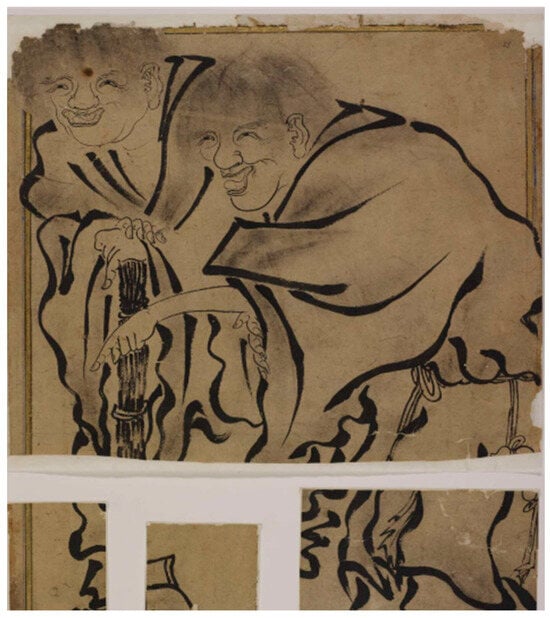
Figure 1.
Two Saints of Harmony c. 1400–1500, 30 × 36.1 cm, Staatsbibliothek zu Berlin, Berlin, image cited from: https://digital.staatsbibliothek-berlin.de/werkansicht?PPN=PPN73601389X&PHYSID=PHYS_0133&view=overview-toc&DMDID=DMDLOG_0133 (accessed on 4 November 2023) © STAATSBIBLIOTHEK ZU BERLIN Preussischer Kulturbesitz, Orientabteilung.
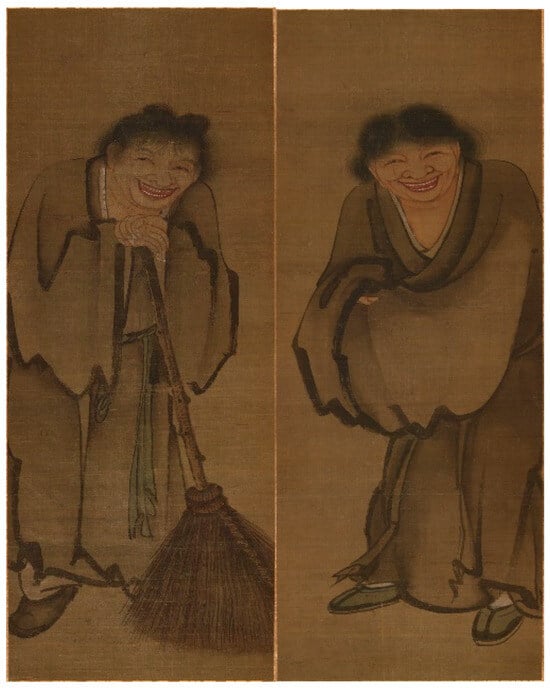
Figure 2.
Two Saints of Harmony 14th century, Tokyo National Museum, Tokyo, image cited from: https://colbase.nich.go.jp/collection_items/tnm/TA-148?locale=en (accessed on 4 November 2023) © ColBase (https://colbase.nich.go.jp/).
5. Zen Aesthetics in Jāmiʿ al-Tavārīkh
From the seventh century onward, following the overthrow of the Sasanian Empire (224–651) by the Arabs, Iran successively fell under the rule of the Umayyad (661–750) and Abbasid Caliphate (750–1258). The Islamic art that emerged within this vast Arab empire integrated characteristics of Persian, Central Asian, Mesopotamian, Byzantine, and even Egyptian art (Āzhand 2016, p. 94). Due to the ambiguous stance of the Islamic doctrine towards figurative art, painting primarily appeared in the form of book illustrations during this era, often steering clear of figurative themes. In the later phase of the Abbasid Caliphate, several regional powers emerged in Iran, with the Seljuk Empire (1037–1194) having the widest dominion and exerting the greatest influence on artistic development. The sponsored manuscripts during this time varied in themes, and the styles of illustrations also differed, making it challenging to describe the style of Persian painting uniformly. The surviving illustrations from the 10th to 13th centuries predominantly feature scientific works, such as Kitāb Ṣuvar al-Kavākib (The Book of Fixed Stars) and Manāfiʿ-i Hayavān (The Benefits of Animals).
In contrast to the disjointed development of Persian art, the influence of Chinese art on Persia remained uninterrupted. Since the westward transmission of Chinese silk textiles during the Western Han period (202 BC-8 AD), Chinese art has garnered admiration in Iran and throughout the Middle East. The lingzhi 靈芝-shaped clouds on Chinese textiles and dragon–phoenix patterns on porcelain are sources of inspiration in Persian painting. However, during the eleventh, twelfth, and thirteenth centuries, the impact of Chinese pictorial traditions on Iranian art was sporadic (Kadoi 2009, p. 126). After the Mongols came to power in Iran, the increased quantity of Chinese artworks led to a peak in the influence of Chinese painting, prompting development in Persian painting and the formation of the first school of Persian painting, the Tabriz school. The main characteristics of this school include prominent depictions of figures, bold and vigorous lines, and the use of vibrant colors.
The Jāmiʿ al-Tavārīkh of 1314–1315 stands as one of the best examples of the Tabriz school. The influence of Chinese painting is obvious within this manuscript: the characters’ facial features distinctly reflect oriental traits, and various compositional elements, including clothing, weapons, animals, and plants, also bear a close resemblance to Chinese prototypes. Under the patronage of Mongol rulers, the themes of the illustrated manuscripts underwent a significant shift from scientific and bestiary books to historical and heroic volumes. Simultaneously, the focus of illustrations also shifted from animals to human figures. The illustrators of this manuscript who lacked models to refer to inevitably turned their attention to graphic materials from other countries, trying to find applicable fragments or elements to create new classics. It is in these paintings that the imprint of Chinese art becomes most apparent. Among all the Chinese impact, the influence of Zen aesthetics on the Jāmiʿ al-Tavārīkh of 1314–1315 primarily manifested in three aspects: theme, brushwork, and compositional elements.
5.1. The Beauty of Shanshui
There are two remarkable illustrations in the 1314–1315 Jāmiʿ al-Tavārīkh: The Mountains of India (MSS 727, f. 21a, Figure 3) and Maitreya’s Enlightenment (MSS 727, f. 36b, Figure 4). Both illustrations are distributed in the section of Jāmiʿ al-Tavārīkh: History of India. These two illustrations are regarded as the earliest known examples of pure landscape paintings within the Islamic world (Gray 1995, p. 25; Kadoi 2009, p. 167). In The Mountains of India, the upper section presents the mountains in the distance. Most of the mountains are outlined with green grass, while the main parts of the mountains are colored with blue, brown, and gray in a gradient form. The spaces between the mountains are adorned with curved pine trees. A broad stream in the lower part serves as the foreground, employing a painting method for the waves that melds Chinese and Mesopotamian styles. Two fish and two waterfowls in the water are the only creatures in this illustration. On the other hand, the textual description of Maitreya’s Enlightenment, which is written above and below the painting box, describes the scene where 84,000 followers laid under the shade of trees when Maitreya became enlightened, witnessing Maitreya’s revelation from heaven. However, contrary to this, the painters only depicted several vigorous trees with a stream running through them. There is no trace of Maitreya or any followers. Güner Inal highlights that the way the tree trunks are cut off by the border is borrowed from Chinese paintings (Inal 1975). The shanshui theme painters’ choice to depict related text is another influence of Chinese art.
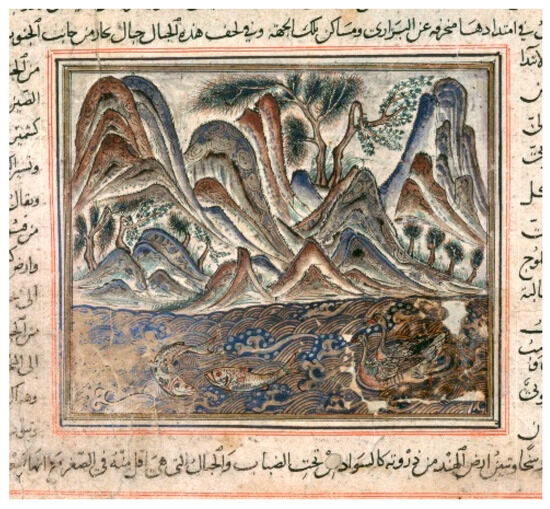
Figure 3.
The Mountains of India 1314–1315, 12 × 14 cm, Khalili Collection of Islamic Art, London, image cited from: https://www.khalilicollections.org/collections/islamic-art/khalili-collection-islamic-art-the-jami-al-tawarikh-of-rashid-al-din-mss727-folio-21a/ (accessed on 4 November 2023) © Khalili Collection of Islamic Art.
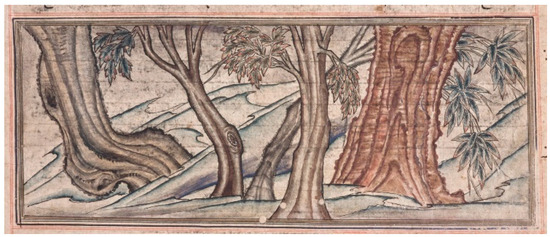
Figure 4.
Maitreya’s Enlightenment 1314–1315, 12 × 14 cm, Khalili Collection of Islamic Art, London, image cited from: https://www.khalilicollections.org/collections/islamic-art/khalili-collection-islamic-art-the-jami-al-tawarikh-of-rashid-al-din-mss727-folio-36b/ (accessed on 4 November 2023) © Khalili Collection of Islamic Art.
In Persian paintings, the function of the landscape is to provide a context or setting for narrating stories (Soucek 1980, p. 86). Nasrin Dastan, an Iranian painter and scholar, posits that Iranian painters do not perceive nature as an entity independent of human feelings and emotions (Dastan 2022, p. 35). This perspective explains why Persian paintings rarely feature landscapes devoid of figures. Nevertheless, two landscape paintings in the Jāmiʿ al-Tavārīkh of 1314–1315 broke this convention, potentially influenced by the abundance of shanshui paintings from China. This influence prompted Persian painters to embrace this theme. According to the research of Toh Sugimura, a scholar investigating Persian muraqqaʿs in the library of the Topkapı Palace Museum, the themes of Chinese paintings in the muraqqaʿs primarily fall into four categories: figures, shanshui, flowers and birds, and animals. Although shanshui paintings are relatively scarce, it is discernible which type captured the attention of Persian painters. For instance, in an imitation by Persian painters known as Autumn Scenery (Figure 5), the entire landscape comprises mountains, water streams, and trees. These three elements signify a shift in the background components of Persian paintings since the early 14th century.
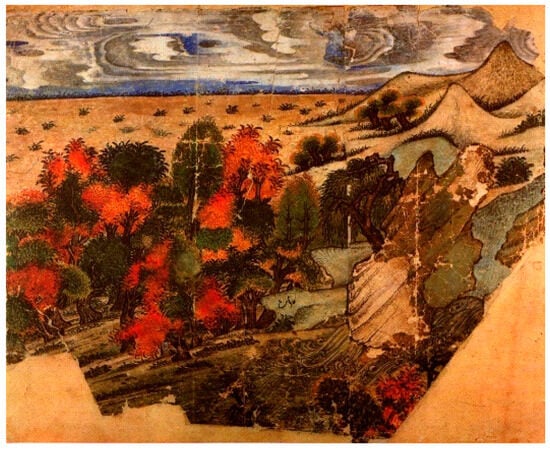
Figure 5.
Autumn Scenery c. 1300–50, Topkapı Palace Museum, Istanbul, image cited from: (Kadoi 2009, p. 220, figure 6.12).
Although the Chinese influence on Persian paintings in the 13th century is undeniable, the style and composition of background elements were retained predating the Mongol period. Specifically, aside from the central figures or animals, the background remains unadorned, with decorative elements such as grass, trees, or sky only sporadically incorporated. Notably, works like ʿAlā al-Dīn ʿAṭā Malik Juvaynī’s Tārīkh-i Jahān-gushā (History of the World Conqueror) from the Bibliothèque nationale de France (Paris suppl. Per. 205), produced in 1290, and Ibn Bakhtīshūʿ’s Manāfiʿ-i Hayavān (The Benefits of Animals) from the Morgan Library and Museum (M. 500), illustrated around 1300, exhibit plain and lifeless backgrounds. In contrast to Persian painting, Chinese painting designates a specific category for landscapes—shanshui painting. The proliferation of shanshui paintings significantly increased with the advent of Zen Buddhism and the participation of scholar-officials and literati, imbuing it with deeper connotations and important aesthetic value. Unlike human figures, plants, and animals, shanshui serves as a distinctive feature in Zen paintings. Zen painters employ implicit suggestions rather than direct depictions in shanshui paintings, encouraging viewers to construct the entire picture through comprehension and imagination (Cahill 2018, p. 106).
In Zen painting, the most representative shanshui theme is the Eight Views of the Xiao and the Xiang Rivers 瀟湘八景圖. Many famous Zen painters have left paintings on this theme. Among them, the Eight Views of the Xiao and the Xiang Rivers (Figure 6)8 by the late Song Dynasty Zen monk Muxi 牧溪 is considered particularly valuable. Although the scenery of the eight paintings varies, the compositional elements, comprising mountains, water, and trees, remain consistent. Compared to the exquisite imperial court paintings and delicate ornamentation in the artwares, a distinct characteristic of shanshui paintings when depicting landscapes is the omission of detailed sky portrayals. In order to convey an ethereal ambiance, shanshui paintings often depict scenes with fog, rain, or snow, precluding detailed depictions of a blue sky and white clouds. This approach to landscape representation likely influenced the Jāmiʿ al-Tavārīkh of 1314–1315. In The Mountains of India (Figure 3) and The Mountains between India and Tibet (MSS 727, f. 22a, Figure 7), mountains, water, and trees constitute the primary elements shaping the outdoor scenery, with no depiction of sky or cloud. Nevertheless, while absorbing shanshui painting, Persian painters also made some adjustments to be in line with Persian aesthetic preferences. They added strong colors and shadows to the mountains, emphasizing decorative features while illustrating water flows. In The Mountains between India and Tibet, a notable issue arises where the painters struggle to manage the proportional relationship between foreground figures and background mountains. This challenge may stem from the fact that the Chinese shanshui paintings referenced by Persian painters predominantly feature pure landscapes, with small or absent human figures. Persian painters had to employ their imagination to integrate characters seamlessly into the landscape.
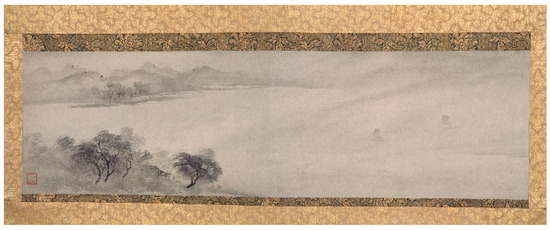
Figure 6.
Returning Sails off the Distant Shore Southern Song, 32.5 × 112.3 cm, Kyoto National Museum, Kyoto, image cited from: http://www.ltfc.net/view/SUHA/6089880533ad8750e9a6c25d (accessed on 12 December 2023).
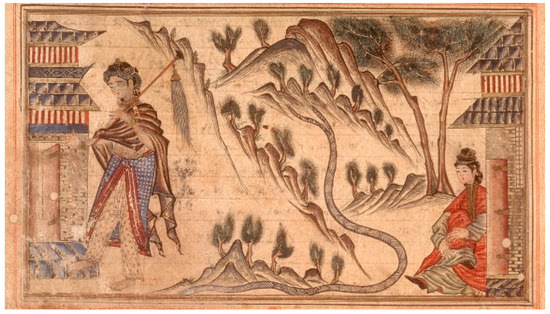
Figure 7.
The Mountains between India and Tibet 1314–1315, Khalili Collection of Islamic Art, London, image cited from: (Blair 1995, p. 77, figure 42). © Khalili Collection of Islamic Art.
Maitreya’s Enlightenment (Figure 4) is another painting of significance that has garnered extensive scholarly discussion. Sheila Canby pointed out the similarities between this illustration and a section of Fan Long’s 樊隆 Sixteen Arhat 十六應真圖 (Canby 1993, p. 304). Fan Long is a crucial Zen painter in the Southern Song Dynasty and a follower of the renowned Zen painter Li Gonglin 李公麟 from the Northern Song Dynasty. Two paintings exhibit comparable ground lines and tree arrangements, especially the distinctive bend of the trees. The difference between the two paintings is that the focus of the Sixteen Arhat is an arhat in white, while Maitreya’s Enlightenment lacks a central character. It is, indeed, an anomaly that Persian paintings, which attach great importance to human figures, do not show the protagonist. This deviation from the usual emphasis on human figures in Persian paintings may be attributed to Maitreya and his spiritual realm being perceived as infinite, transcending limited human appearances. The painters likely opted for a natural element to convey the transcendence and infinity of Maitreya (Pan 2023, p. 24), reminiscent of how the Bodhi tree in Buddhist pictorial tradition symbolizes the moment of enlightenment for Buddha. In Buddhist paintings, especially Zen paintings, the use of specific scenery or objects to symbolize individuals or events is a distinctive characteristic. For instance, the Southern Song Dynasty Zen painter Yujian 玉澗 employed the Lushan Waterfall 廬山瀑布 to reference the classic story Three Smiling People in front of the Tiger Brook9 虎溪三笑. Although the text corresponding to The Mountains of India describes nature, and the text corresponding to Maitreya’s Enlightenment recounts a story, both illustrations are presented as pure landscape paintings. The painters of the 1314–1315 Jāmiʿ al-Tavārīkh were evidently inspired by the intense observation of shanshui paintings demonstrated by Chinese Zen painters. Recognizing the significance of landscapes is of cardinal importance in the history of Persian painting (Kadoi 2009, p. 237). However, since Persian painters may not have fully grasped the philosophical nuances of Chinese shanshui painting within the context of Zen, and concurrently, Persian art gradually formed its own text–image narrative logic under the influence of Sufi thought, pure landscape painting did not gain much attention in Persian painting. But this brief attempt to illustrate the landscape in the 1314–1315 Jāmiʿ al-Tavārīkh still has its significance. It presents the diverse features of the Persian painting style in the early stages of its development and underscores the initiative and aesthetic preference of Persian painters in the interaction with other artistic traditions.
5.2. Light Ink in Color Painting
Discovery of the Well Zamzam (Or. Ms. 20, f. 41r, Figure 8) in the Jāmiʿ al-Tavārīkh: History of the Jews recounts the narrative of ʿAbd al-Muṭṭalib, the grandfather of the Prophet Muhammad, and his son Al-Ḥārith in their quest for Zamzam. During their journey, they encountered a crow pecking ants, mirroring the revelation received by ʿAbd al-Muṭṭalib. In the foreground of the painting, the two figures stand on the left side, looking down at the crow feeding on ants in the lower right corner. The most confusing part of the painting is the mountains outlined by light ink in the background. David Talbot Rice suggests that this segment might be incomplete or influenced by the color wash technique in Chinese ink painting (Rice 1976, p. 95). By studying details of the painting, it can be figured out that the light ink mountains in the painting are not in unfinished form; instead, they are a precious experiment by the Persian painters. In Persian painting, the customary procedure involves outlining and coloring. Painters paint different colors in stages according to prior arrangements. The two characters on the left side of the painting demonstrate meticulous detail, from facial features to clothing, showcasing a careful completion of all painting steps. The rhombus and floral designs on their garments are intricate, also highlighting the thoroughness of the painters. The mountains in the background are drawn with thick lines of light ink. Since the ink is extremely light, it is incapable of adequately concealing the delicate outlines delineated in the first step of composition. There are small circles to distinguish different layers of the mountains, indicating the finished state of the light ink mountains. These mountains are not mentioned in the text, reminding viewers of the story of Hajar, the wife of Prophet Ibrahim, recorded in the Ṣaḥīḥ al-Bukhārī. In order to find water sources, Hajar searched between the two mountains of Safa and Marwah. She finally discovered the well Zamzam with the help of an angel. Consequently, the painters attempted to reproduce the two mountains in the painting, but the brushwork they used was never reproduced in Persian painting. Nevertheless, it stands as one of the most telling examples of Zen influence in the 1314–1315 Jāmiʿ al-Tavārīkh.
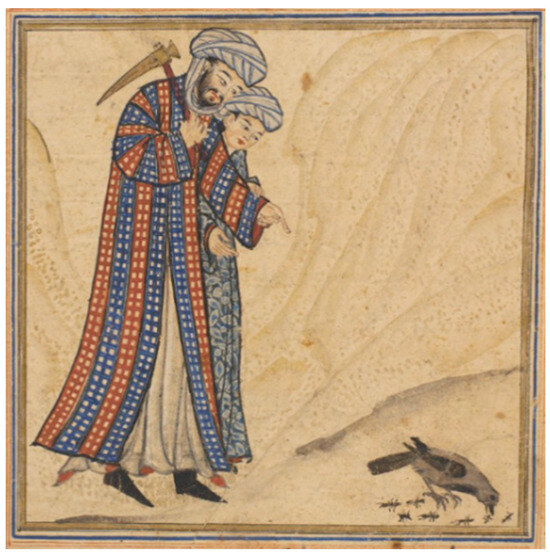
Figure 8.
Discovery of the Well Zamzam 1314–1315, University of Edinburgh, Edinburgh, image cited from: https://images.is.ed.ac.uk/luna/servlet/detail/UoEsha~4~4~64742~103064?qvq=q%3Arashid&mi=0&trs=399 (accessed on 4 November 2023) © Heritage Collections, University of Edinburgh.
Persian painters possessed a distinct advantage in emulating Chinese painting, primarily owing to their use of the same brush. This facilitates the mastery of brushwork ranging from gongbi 工筆 (meticulous painting) to xieyi 寫意 (freehand brushwork) by Persian painters. The prevalence of imitations of gongbi paintings, particularly those featuring flowers, birds, and figures in the muraqqa’s, underscores Persian painters’ preference for this delicate and skillful painting style. In contrast, xieyi painting, characterized by a different aesthetic, is less common in Persian painting, appearing sporadically in specific elements of individual paintings, such as the depiction of Hanshan and Shide’s hair in Two Saints of Harmony (Figure 1) and light ink mountains in Discovery of the Well Zamzam (Figure 8). As mentioned in the previous section, Persian painters noticed the significance of mountains in the paintings. While incorporating this theme from Chinese painting, they retained a Persian manner in the details. For instance, in The Mountains of India (Figure 3), the outlines of the mountains are thick, and the colors are heavy. A similar stylistic approach is evident in The Annunciation (Or.MS.20, f. 22r, Figure 9), where the mountains, drawn with thick outlines, assume a prominence akin to the two central figures. Richard Ettinghausen points out that Persian paintings, while imitating Chinese paintings, lack a sense of reality and space, attributing this deficiency to the painters’ unfamiliarity with the artistic and visual principles of Chinese shanshui paintings (Ettinghausen 1979b, p. 247). However, in Discovery of the Well Zamzam, the mountains painted in light ink perfectly bear the responsibility of background. They fulfill the obligation of decorating the blank space, providing the painting with a sense of depth to accentuate the central figures. An intriguing detail in the painting is a partially completed black line on the left side, prompting speculation that the painter initially intended to use heavy outlines for the mountains, as seen in The Annunciation. Nevertheless, influenced by shanshui paintings, the painters departed from tradition and opted for a light ink brushwork approach.
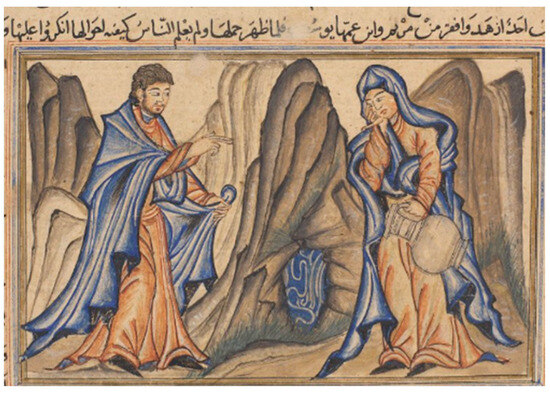
Figure 9.
The Annunciation 1314–1315, University of Edinburgh, Edinburgh, image cited from: https://images.is.ed.ac.uk/luna/servlet/detail/UoEsha~4~4~64742~103064?qvq=q%3Arashid&mi=0&trs=399 (accessed on 4 November 2023) © Heritage Collections, University of Edinburgh.
Zen painters are skilled in employing variations in ink to convey different colors. In their paintings, ink is divided into five colors: dry, wet, thick, light, and clear. Among them, light ink color is most popular; it is considered the iconic style of Zen painting during the Southern Song Dynasty. Muxi’s paintings serve as notable examples of light ink usage, particularly evident in the Eight Views of the Xiao and the Xiang Rivers, where all the paintings employ light ink brushwork. In one of them, Returning Sails off the Distant Shore 遠浦歸帆圖 (Figure 6), the continuous mountains in the upper left corner are delicately outlined with light ink, creating an effect where the mountains appear as light shadows. Zen painters utilize light ink brushwork to evoke ethereal effects, aiming to perceive truth and reality through the play of shadows and attain enlightenment in the Zen tradition. In the context of Discovery of the Well Zamzam, the mountains painted in light ink produced a distant and hazy effect, while a relatively dark ink line in the right foreground, along with the presence of a black crow, establishes a contrasting effect with the light ink mountains, effectively highlighting the foreground. However, it is essential to acknowledge that the light ink brushwork in Zen paintings is spontaneous and coherent, while the application of light ink brushwork in Discovery of the Well Zamzam still follows certain patterns of Persian painting to depict mountains, lacking the vitality observed in Zen art. As with landscape themes, light ink brushwork is a rare attempt to imitate Chinese Zen paintings. Although it failed to capture the essence of light ink, these light ink mountains still created depth and reflected the Persian painters’ pursuit of spatial ideas. This innovative move is one of the influences of Chinese painting on Persian painting, the transformation from two-dimensional to three-dimensional painting, and a good starting point for understanding Persian painters’ responses to Chinese Zen paintings.
5.3. Saints and Rocks/Mountains
In addition to shanshui themes and light ink brushwork, further notable evidence in the illustrations of the Jāmiʿ al-Tavārīkh of 1314–1315 likely influenced by Chinese Zen painting is the fusion of saints with rocks/mountains. In the depiction of Prophet Muhammad Receiving First Revelation (Or.Ms.20 f. 45v, Figure 10) within the Jāmiʿ al-Tavārīkh: History of the Prophets, the Prophet Muhammad, positioned on the right, is seated on a rock, cradling his right leg. Owing to the absence of visual depth, discerning whether the elements surrounding him are rocks or mountains proves challenging. On the left, the archangel Jabrāʾīl leans forward, pointing his left hand towards the Prophet to signify the individual with whom he communicates. David Talbot Rice noted that the use of blue, green, and gold colors in the rocks/mountains is Chinese paintings’ influence (Rice 1976, p. 103). Additionally, the incorporation of saints with rocks/mountains in this illustration reflects another Chinese influence, serving as a common compositional element in Zen figure paintings.
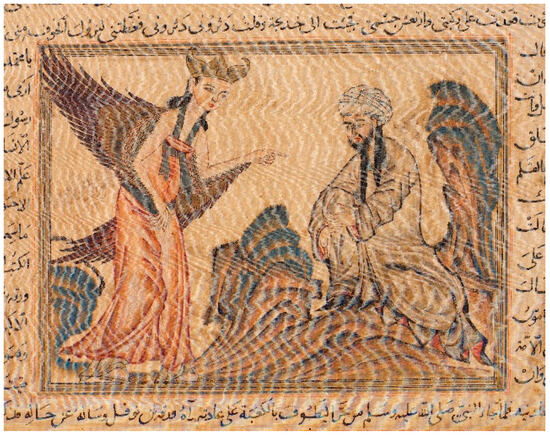
Figure 10.
Prophet Muhammad Receiving First Revelation 1314–1315, University of Edinburgh, Edinburgh, image cited from: https://images.is.ed.ac.uk/luna/servlet/media/book/showBook/UoEsha~4~4~64742~103064 (accessed on 4 November 2023) © Heritage Collections, University of Edinburgh.
Figure painting constitutes the category with the largest number of Zen paintings. In depictions of Buddhist and Zen narratives, numerous figures are portrayed in conjunction with rocks/mountains. An exemplar is the theme of Bodhidharma Meditating Facing a Cliff 達摩面壁 in paintings featuring the First Patriarch of the Zen school, Bodhidharma. In the painting of the same name allegedly painted by Yan Ciping 閻次平 (Figure 11), Bodhidharma sits cross-legged on a rock, facing a cliff. Behind him is the Second Patriarch Huike 慧可, the successor to Bodhidharma. Another theme is Shakyamuni Coming Down from the Mountains, which depicts the story of Shakyamuni, after six years of ascetic practice in the mountains, finally coming out of the mountains when he realized that practicing asceticism blindly is useless. In Liang Kai’s 梁楷 painting of the same name (Figure 12), the peaks appear behind Shakyamuni in a diagonal arrangement, reflecting the inner power of Shakyamuni. Some paintings depict arhats practicing in connection with rocks/mountains. Take Muxi’s The Arhat as an example; an arhat sits cross-legged on a rock and the mountains behind surrounded him in a wrapping manner. In these paintings, rocks/mountains denote the meditation sites of Buddhist monks, with their shapes subtly implying inner strength. In addition, a recurrent theme in figure paintings of the Song and Yuan Dynasties is Guanyin 觀音 Lying on a Rock, such as the scroll of Muxi’s The Painting of Guanyin (Figure 13), in which Guanyin reclines on her side on a rock. This posture not only echoes the relationship between the Buddhist figure and the rock, but also suggests a potential pictorial source for the portraits of Chinese emperors in a reclined posture in the 1314–1315 Jāmiʿ al-Tavārīkh: History of China.

Figure 11.
Bodhidharma Meditating Facing a Cliff Song Dynasty, 116.5 × 46.4 cm (painting only), The Cleveland Museum of Art, Cleveland, image cited from: https://www.clevelandart.org/art/1972.41#imageonly (accessed on 4 November 2023).

Figure 12.
Shakyamuni Coming Down from the Mountains 13th century, Tokyo National Museum, Tokyo, image cited from: https://colbase.nich.go.jp/collection_items/tnm/TA-617?locale=en (accessed on 4 November 2023) © ColBase (https://colbase.nich.go.jp/).
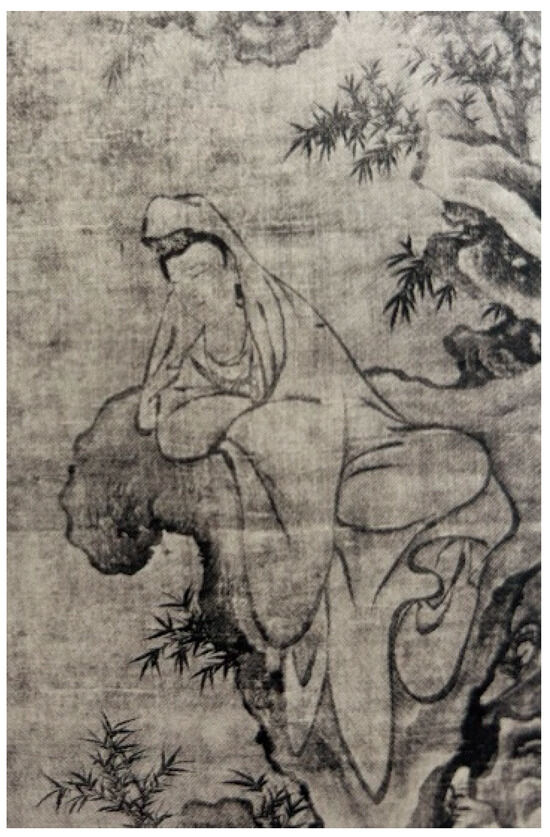
Figure 13.
The Painting of Guanyin Southern Song, 154.5× 93.7 cm, Enkaku-ji, Okinawa, image cited from: (Li 2021, p. 66, figure 3-a).
When examining the painting Prophet Muhammad Receiving First Revelation in isolation, two plausible reasons emerge for the painters’ choice of rocks/mountains to surround the Prophet. This could either be attributed to the influence of Zen figure paintings or connected to ‘horror vacui’10, a guiding principle in Islamic art. However, this combination recurs throughout the manuscript, necessitating a singular explanation for the depiction of rocks/mountains. In The Death of Moses on Mountain Nebo (MSS 727 f. 54a, Figure 14) within the section of the Jāmiʿ al-Tavārīkh: History of the Jews, the rocks of the bed are depicted dramatically to suit the demands of the painters, stressing the significance of Moses. Similarly, in Muhammad Conversing with Abu Bakr on Their Way to Medina (Or.Ms.20 f. 57r) in the Jāmiʿ al-Tavārīkh: History of the Prophets, the painters located Muhammad next to the rocks/mountains. These paintings unveil that this period marked a transition in the incorporation of the saints and rocks/mountains combination, showcasing a feature newly adopted from Chinese figure paintings. After the 1314–1315 Jāmiʿ al-Tavārīkh, this combination gradually became a convention. In the Jāmiʿ al-Tavārīkh of 1425, for instance, a substantial rock stands behind the Prophet Muhammad in Prophet Muhammad Receiving First Revelation (Figure 15). Beyond the Jāmiʿ al-Tavārīkh, similar associations between saints and rocks/mountains appear in other works. In Nezāmī’s Khamsa: Iskandarnāma, Iskandar is depicted in a mountain cave when visiting a Sufi saint. Additionally, in Khamsa: Leylī and Majnūn, when Majnūn lives in the wilderness and practices asceticism like a Sufi saint, painters also tend to put him on a rock.
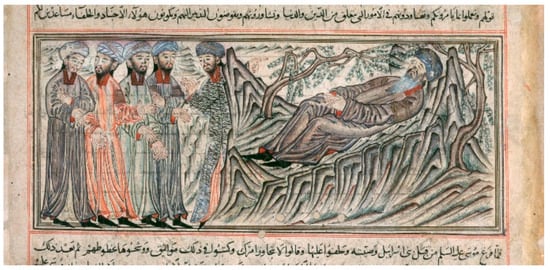
Figure 14.
The Death of Moses on Mountain Nebo 1314–1315, 11 × 25.5 cm, Khalili Collection of Islamic Art, London, image cited from: https://www.khalilicollections.org/collections/islamic-art/khalili-collection-islamic-art-the-jami-al-tawarikh-of-rashid-al-din-mss727-folio-54a/ (accessed on 4 November 2023) © Khalili Collection of Islamic Art.
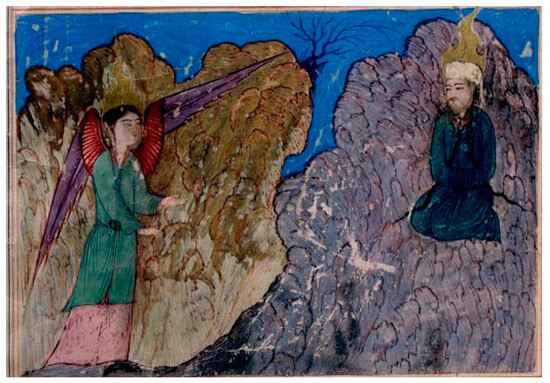
Figure 15.
Prophet Muhammad Receiving First Revelation c. 1425, 15.5 × 22.2 cm (painting only), Metropolitan Museum of Art, New York, image cited from: https://www.metmuseum.org/art/collection/search/451418 (accessed on 4 November 2023).
6. Conclusions
At the beginning of the 14th century, frequent exchanges of people and commodities occurred between the Ilkhanid Dynasty and the Yuan Dynasty. Historical materials also indicate that, when the manuscript of Jāmiʿ al-Tavārīkh was produced in 1314–1315, a certain number of Zen books and paintings were present in Rabʿ-i Rashīdī. The influence of these Zen paintings is reflected in the illustrations of Jāmiʿ al-Tavārīkh in terms of theme, brushwork, and compositional elements. However, the influence of landscape theme and light ink brushwork on Persian painting was not as profound as that of other Chinese painting elements. This disparity can be attributed to differences in the understanding of painting connotations. In Jāmiʿ al-Tavārīkh: History of China, Rashīd al-Dīn introduced the lives of Shakyamuni, Laozi 老子, and Confucius, indicating his awareness of key beliefs in China. However, he did not introduce the schools of Buddhism, like Zen, despite referencing Chinese books written by Zen monks that encompass Zen Buddhism’s history and prominent figures. Rashīd al-Dīn’s disregard for Zen Buddhism permeates into the manuscript’s illustrators, leaving them uninformed about Zen or its artistic expressions. On the contrary, the emergence and development of Zen painting in China at that time was in debt to the propagation of Zen Buddhism, along with the existence of social backgrounds and the literati class. Consequently, when Zen paintings with special religious and cultural connotations are encountered with other civilizations, their deeper implications are often missed. Only Chinese painting elements that conform to universal aesthetics tend to leave an impression. During the early fourteenth century, Iranian artisans demonstrated openness towards Chinese art. Chinese elements with exquisite style, such as flowers and birds, clouds, and dragons, have been retained. These elements make the pictures richer and more vivid without changing the core of Persian art. Faced with diverse image references from China, including Zen paintings, the illustrators of the 1314–1315 Jāmiʿ al-Tavārīkh were influenced to experiment with landscape theme and light ink brushwork. However, due to inherent aesthetic differences and a limited understanding of Zen paintings, these imitations remained transient. Only the combination of saints and rocks/mountains endured and became a fixed expressive technique in Persian paintings, which also became an example of the encounter between Zen art and Persian art.
Funding
This research was funded by教育部人文社會科學重點研究基地重大項目《東方文學與文明互鑒:多語種古代東方文學插圖本比較研究》grant number: 22JJD750002.
Informed Consent Statement
Not applicable.
Data Availability Statement
No new data were created or analyzed in this study. Data sharing is not applicable to this article.
Conflicts of Interest
The author declares no conflict of interest.
Notes
| 1 | The Jāmiʿ al-Tavārīkh section of Hazine 1653 was produced in 1314 and later included in the Majmaʿ al-Tavārīkh-i Sulṭāniya in the atelier of Shāhrukh (1377–1447). Majmaʿ al-Tavārīkh-i Sulṭāniya was written by Ḥāfiẓ-i Abrū (?-1430), a historical geographer of the Timurid Empire. It is divided into four volumes; the content of the first three volumes is an excerpt from Rashīd al-Dīn’s Jāmiʿ al-Tavārīkh, making it an important reference book while studying Jāmiʿ al-Tavārīkh. |
| 2 | Refugees emerged as a distinctive social group during the Tang and Five Dynasties in China. The appearance of this group was the result of famine, wars, and land annexation. |
| 3 | The Zen monk Nianchang (1282–?) finished the first edition of Fozu Lidai Tongzai (Comprehensive Record of Buddha and the Patriarchs Through the Ages) in 1344 and revised it in 1347. During its compilation, he drew and reproduced content from Jingde Zhuangdeng Lu 景德傳燈錄 (Records of the Transmission of the Lamp of the Jingde Era), Longxing Fojiao Biannian Tonglun 隆興佛教編年通論 (Comprehensive Discussion and Chronology of Buddhism of the Longxing Era), Chanlin Sengbao Zhuan 禪林僧寶傳 (Famous Chan Masters in Buddhist Temples), and other books. For an extensive analysis on Fozu Lidai Tongzai, see Yang (2021). |
| 4 | Written in 1004, this book holds significance as a crucial historical document recording the development of Zen Buddhism in China. It garnered recognition from the contemporary government. For more information, see Yang (2006). |
| 5 | Zuxiu wrote this book in 1164. It is the earliest extant chronicle of the comprehensive history of Buddhism in China. For more information, see Guo (2016). |
| 6 | Free spirit saints in Zen Buddhism indicate the ones who have unique insights, and most of them fall outside the conventional Zen Buddhism lineage. |
| 7 | Hanshan and Shide were two monks from the Tang Dynasty. They were regarded as the incarnations of Manjushri and Samantabhadra. Their images as Zen representatives were established in the Song Dynasty and became a common theme in Zen paintings. |
| 8 | Eight Views of the Xiao and the Xiang Rivers typically comprise eight paintings, with Returning Sails off the Distant Shore representing one theme within this collection. |
| 9 | It refers to the story that happened between the monk Huiyuan, the Taoist Lu Xiujing, and the Confucian Tao Yuanming. Huiyuan had a tradition: he refrained from crossing the Tiger Brook in front of his residence when bidding farewell to guests. However, following an engaging conversation with Lu and Tao, his reluctance to part ways led to an unintentional breach of his own rule. Upon Huiyuan’s realization that he had crossed the brook, defying his customary practice, laughter ensued among both the host and the guests. This story symbolized the harmonious coexistence of the three religions and was a popular theme in Zen paintings during the Southern Song Dynasty. |
| 10 | For more on this, see Ettinghausen (1979a). |
References
- Āzhand, Yaʿqūb. 2016. Nigārgarī-yi Īrān: Pazhūhish-ī dar Tārīkh-i Naqqāshī va Nigārgarī-yi Īrān (1) (Iranian Painting: Research on Persian Painting and Miniature (1)). Tehran: SAMT. [Google Scholar]
- Blair, Sheila S. 1995. A Compendium of Chronicles: Rashid al-Din’s Illustrated History of the World. London: Khalili Collections. [Google Scholar]
- Boyle, John Andrew. 1971. Rashīd al-Dīn: The First World Historian. Iran 9: 19–26. [Google Scholar] [CrossRef]
- Cahill, James. 2018. Tushuo Zhongguo Huihuashi 图说中国绘画史 (Chinese Painting: A Pictorial History). Beijing: Shenghuo Dushu Xinzhi Sanlian Shudian. [Google Scholar]
- Calzolaio, Francesco, and Francesca Fiaschetti. 2019. Prophets of the East: The Ilkhanid Historian Rashīd al-Dīn on the Buddha, Laozi and Confucius and the Question of his Chinese Sources (Part 1). Iran and the Caucasus 1: 17–34. [Google Scholar] [CrossRef]
- Canby, Sheila R. 1993. Depictions of Buddha Sakyamuni in the Jamiʿ al-Tavarikh and the Majmaʿ al-Tavarikh. Muqarnas 10: 299–310. [Google Scholar] [CrossRef]
- Dastan, Nasrin 納斯霖·達斯坦. 2022. Yilang Ximihua zhong de Zhongguo Yuansu 伊朗細密畫中的中國元素 (Chinese Elements in Iranian Miniature Paintings). Zhengzhou: Daxiang Chubanshe. [Google Scholar]
- Du, Jiwen 杜繼文, and Daoru Wei 魏道儒. 2022. Zhongguo Chanzong Tongshi 中國禪宗通史 (General History of Chinese Zen Buddhism). Nanjing: Jiangsu Renmin Chubanshe. [Google Scholar]
- Ettinghausen, Richard. 1979a. The Taming of the Horror Vacui in Islamic Art. Proceedings of the American Philosophical Society 1: 15–28. [Google Scholar]
- Ettinghausen, Richard. 1979b. World Awareness and Human Relationships in Iranian Painting. In Highlights of Persian Art. Edited by Richard Ettinghausen and Ehsan Yarshater. Boulder: Westview Press, pp. 243–70. [Google Scholar]
- Franke, Herbert. 1951. Some Sinological Remarks on Rašîd ad-Dîn’s History of China. Oriens 4: 21–26. [Google Scholar] [CrossRef]
- Gray, Basil. 1978. The World History of Rashid Al-Din; a Study of the Royal Asiatic Society Manuscript. London: Faber and Faber Ltd. [Google Scholar]
- Gray, Basil. 1995. Persian Painting. Geneva: Editions d’Art Albert Skira SA. [Google Scholar]
- Guo, Lin 郭琳. 2016. Xiancun Zuizao Biannianti Fojiao Tongshi Longxing Fojiao Biannian Tonglun Jiazhi Lüeshu 現存最早編年體佛教通史《隆興佛教編年通論》價值略述 (The Value of the Earliest Chronological General Buddhism History Based on Longxing Buddhist Chronicle). Zhongguo Dianji yu Wenhua 中國典籍與文化 4: 30–39. [Google Scholar]
- Inal, Güner. 1975. Artistic Relationship between the Far and the Near East as Reflected in the Miniatures of the Gami At-Tawarih. Kunst des Orients 10: 108–43. [Google Scholar]
- Jahn, Karl. 1967. Rashīd al-Dīn as World historian. In Yádnáme-yi Jan Rypka: Collection of Articles on Persian and Tajik Literature. Prague: Academia, pp. 79–87. [Google Scholar]
- Jiang, Lan 江瀾. 2017. Lun Chanxue yu Song Yuan Wenrenhua de Sixiang Guanlian 論禪學與宋元文人畫的思想關聯 (The Intellectual Association between Zen and Literati Paintings in Song and Yuan Dynasties). Wenyi Yanjiu 文藝研究 12: 126–42. [Google Scholar]
- Kadoi, Yuka. 2009. Islamic Chinoiserie: The Art of Mongol Iran. Edinburgh: Edinburgh University Press. [Google Scholar]
- Levine, Gregory P. A. 2017. The Look and Logos of Zen Art. In Long Strange Journey: On Modern Zen, Zen Art, and Other Predicaments. Edited by Gregory P. A. Levine. Honolulu: University of Hawai’i Press, pp. 75–96. [Google Scholar]
- Li, Jing 李靜. 2021. Yue Shang Gufeng: Nansong Chanzong Huihua Yanjiu 月上孤峰——南宋禪宗繪畫研究 (The Moon Above a Solitary Peak: A Study of Zen Paintings of the Southern Song Dynasty). Beijing: Renmin Meishu Chubanshe. [Google Scholar]
- Pan, Sangrou 潘桑柔. 2023. Wu yu You de Xiangyu: Shiji Yindu Xinde yu Keshimi’er Shi Shanshui Niepan Zhuti Chatu Zai Yanjiu “無”與“有”的相遇:《史集·印度、信德與喀什米爾史》山水與涅槃主題插圖再研究 (A Re-Examination of Landscape and Nirvana Themed Illustrations in the History Collection-History of India, Sindh and Kashmir). Meishu Yanjiu 美術研究 4: 19–26. [Google Scholar]
- Rashīd al-Dīn, Fażl Allāh. 1947. Kitāb-i Mukātibāt-i Rashīdī (The Letters of Rashīd al-Dīn). Edited by Muḥammad Shafī. Lahore: Panjab University Oriental Publications. [Google Scholar]
- Rashīd al-Dīn, Ṭabīb. 1979. Savāniḥ al-Afkār-i Rashīdī (Changes of Rashīd al-Dīn’s Thoughts). Edited by M. Dānishpazhūh. Tehran: Intishārāt-i Kitābkhāna-i Markazī va Markaz-i Asnād. [Google Scholar]
- Rice, David Talbot. 1976. The Illustrations to the World History of Rashīd al-Dīn. Edinburgh: Edinburgh University Press. [Google Scholar]
- Rong, Xinjiang 榮新江. 2015. Sichou zhi Lu yu Dong Xi Fang Wenhua Jiaoliu 絲綢之路與東西方文化交流 (The Silk Road and Cultural Interaction between East and West). Beijing: Beijing Daxue Chubanshe. [Google Scholar]
- Schlütter, Morten. 2008. How Zen Became Zen: The Dispute over Enlightenment and the Formation of Chan Buddhism in Song-Dynasty China. Honolulu: University of Hawai’i. [Google Scholar]
- Soucek, Priscilla. 1980. The Role of Landscape in Iranian Painting in the Fifteenth Century. In Landscape Style in Asia, Colloquies on Art & Archaeology. Edited by Watson William. London: University of London, pp. 86–110. [Google Scholar]
- Steinhardt, Nancy Shazman. 1987. Chinese Ladies in the Istanbul Albums. In Islamic Arts: An Annual Dedicated to the Art Culture of the Muslim World. Edited by Ernst J. Grube and Eleanor G. Sims. Oxford: Oxford University Press, pp. 77–84. [Google Scholar]
- Wang, Yidan 王一丹. 2006. Bosi Lashite Shiji Zhongguoshi Yanjiu yu Wenben Fanyi 波斯拉施特《史集·中國史》研究與文本翻譯 (A Study and Collated Translation of Rashīd al-Dīn’s History of China in Jāmiʿ al-Tavārīkh). Beijing: Kunlun Chubanshe. [Google Scholar]
- Wei, Guang 魏廣. 2018. Yuanmu Xuhe Neiwai Mingche: Qiantan Chanzong yu Yuandai Huihua 淵穆虛和, 內外明徹——淺談禪宗與元代繪畫 (Fine and Peaceful, Clear Inside and Outside: A Brief Discussion on Zen Buddhism and Yuan Dynasty painting). Shandong Yishu 山東藝術 6: 80–83. [Google Scholar]
- Yang, Shuting 楊舒婷, and Man Gu 顧漫. 2022. Yilihan Zhongguo Keji Zhenbaoshu Futu Laiyuan Tanxi 《伊利汗中國科技珍寶書》附圖來源探析 (The Sources of the Attached Drawings to Tanksuqnameh). Zhonghua Yishi Zazhi 中華醫史雜誌 1: 12–20. [Google Scholar]
- Yang, Zengwen 楊曾文. 2006. Songyuan Chanzongshi 宋元禪宗史 (A History of Zen Buddhism in the Song and Yuan Dynasties). Beijing: Zhongguo Shehui Kexue Chubanshe. [Google Scholar]
- Yang, Zhifei 楊志飛. 2021. Fozu Lidai Tongzai Banben Yuanliu Kao 《佛祖歷代通載》版本源流考 (A Study of the Versions of Fozu Lidai Tongzai). Foxue Yanjiu 佛學研究 1: 63–77. [Google Scholar]
- Yu, Yusen 俞雨森. 2019. Shisi Shiji Wanqi zhi Shiwu Shiji Bosi Gongting Shoucang de Daoshihua 14世紀晚期至15世紀波斯宮廷收藏的道釋畫 (Daoist Paintings Collected by the Persian Court from the Late 14th to the 15th Century). In Makeboluo yu Shi zhi Shisi Shiji de Sichou zhi Lu 馬可·波羅與10–14世紀的絲綢之路 (Marco Polo and the Silk Road from the 10th to 14th Centuries). Edited by Xinjiang Rong 榮新江 and Baohai Dang 党寶海. Beijing: Beijing Daxue Chubanse, pp. 383–404. [Google Scholar]
Disclaimer/Publisher’s Note: The statements, opinions and data contained in all publications are solely those of the individual author(s) and contributor(s) and not of MDPI and/or the editor(s). MDPI and/or the editor(s) disclaim responsibility for any injury to people or property resulting from any ideas, methods, instructions or products referred to in the content. |
© 2024 by the author. Licensee MDPI, Basel, Switzerland. This article is an open access article distributed under the terms and conditions of the Creative Commons Attribution (CC BY) license (https://creativecommons.org/licenses/by/4.0/).